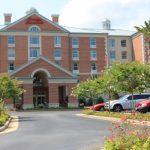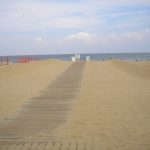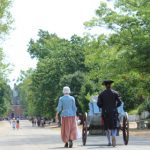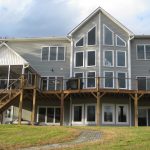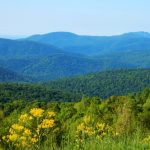― Henry David Thoreau, Walden
Lewis Ginter Botanical Garden in Richmond, Virginia is an 80-acre attraction containing an impressive variety of gardens and water features connected by a network of trails.
Lewis Ginter has been recognized as one of the top public gardens by USA Today and The Travel Channel with over 300,000 visitors per year. There are exhibits and activities to appeal to everyone who enjoys being outdoors, and the enchanting landscape is a popular venue for weddings and other special events.
How to Get There
The garden is located at 1800 Lakeside Avenue on the north side of Richmond, Virginia between Interstates 95 and 64. From Interstate 95 north, take exit 80 for Lakeside Ave. and follow it north about 1.7 miles to the garden. From Interstate 95 south, take exit 83B onto Parham Road west; go .3 mile and turn left on Brook Road (US 1). Go .9 mile and turn right onto Lakeside Avenue; proceed .7 mile to the garden. Commercial airline service is available at Richmond International Airport (RIC), about 15 miles southeast of the garden. (Note: GRTC Transit System buses are accessible but do not serve Lewis Ginter Botanical Garden; the closest stop is 2 miles away on bus route 93 at Azalea Avenue and Brook Road.)
Planning Your Visit
The garden is open daily 9:00am to 5:00pm except Thanksgiving, December 24 and December 25. During the summer months hours are extended until 9:00pm on Thursdays. Allow at least 2-3 hours to explore the grounds, but you can easily spend most of a day if you want plenty of time for a meal, photography, and watching birds, insects and wildlife. I have been to the garden several times during different seasons of the year and there is always something to see; A visit to the website will fill you in on “what’s blooming now”. Consider the forecast and your personal weather tolerance when you plan your visit. Virginia summers are usually hot and very humid with afternoon thunderstorms.
Fall weather is cooler and prompts a colorful foliage display and a bounty of berries and seeds that attract birds and animals. Winter brings holiday decorations and the spectacular GardenFest of Lights, but also colder temperatures and even occasional ice and snow. In Spring the garden is warming up and bursting with blooms mid-April through May; this season may be the most splendid but also the most crowded (particularly during the annual Historic Garden Week). Dress comfortably and be prepared for sun exposure and traveling some distance between exhibits. Note that pets and outside food are not permitted.
What to See and Do
When you arrive at the garden, there is designated accessible parking in all lots, as well as a level loading area in front of the Robins Visitors Center. Lot B for group parking has the closest, most level approach. Enter the gardens through the Visitors Center which contains the admission and information desks, gift shop, cafe’, art exhibit and restrooms. It is fully accessible, with power doors, tile floors and accessible restrooms and drinking fountains. The garden is a nonprofit organization that is funded through donations and admission fees (see website for current prices). Save some time to browse the gift shop on your way out; it has a tempting selection of gardening supplies and garden-themed gifts and housewares.
The Kelly Education Center is located adjacent to the Visitors Center and contains a comfortable, inviting library of resources on plants and gardening plus a collection of art and sculpture. There’s also a children’s area with age-appropriate displays, puzzles and artifacts. The library is open weekdays 10:00am to 4:00pm and weekends 1:00-4:00pm. This building is also fully accessible and contains a restroom.
Wander through the Central Garden to the Conservatory, a dazzling 11,000 square-foot glass greenhouse with a 63-foot-tall dome. It houses delicate tropical and exotic plants such as palms, cacti and orchids. During the warmer months of the year, the North Wing features a walk-through exhibit of live butterflies. The conservatory is accessible with ramped entrances and wide, hard-surface walkways.
Certainly the main attraction is the stunning landscape: over a dozen different themed gardens are accented with sculpture, gazebos, arches and water features like streams, fountains and reflecting pools. Just a few of the highlights are the dancing fountain in the Central Garden, the Rose Garden with stone arches and pavilions surrounded by more than 70 varieties of roses, the Cherry Tree Walk along the banks of Sydnor Lake, the Asian Valley featuring dramatic trees and a bubbling brook, the boardwalk through the West Island Wetland, and the Children’s Garden with its 100-year-old mulberry tree, WaterPlay area, and wheelchair-accessible treehouse.
Approximately 2 miles of pathways and trails meander among the gardens and most of them have hard surfaces like concrete, brick, pavers or asphalt. There are grades in a few places where wheelchair users may be grateful for a little assistance. For instance, the main path drops 22 feet over 520 feet of walkway between the Central Garden and the Lotus Bridge over Sydnor Lake. Accessible restrooms are located at the Tea House in Asian Valley and in the Children’s Garden. Many benches for resting or relaxing are located throughout the gardens and along the pathways. Wheelchairs are available for loan at the Visitor Center.
Historic Bloemendaal House was the home of Grace Arents, the niece of entrepreneur Lewis Ginter, who inherited part of the property when Ginter died in 1897. She purchased additional land, including this building that was the former Lakeside Wheel Clubhouse for bicyclists. She renovated and renamed the property Bloemendaal Farm. Bloemendaal means “flower valley” – an appropriate name considering the extensive gardens she nurtured around the house. When Miss Arents died, she left the property to the City of Richmond to be used as a park and botanical garden in memory of her uncle. The gardens she planted in 1914 have been restored and the house is open for tours and special events. Accessible restrooms are available.
In addition to the above attractions, Lewis Ginter Botanical Garden offers a full schedule of lectures, tours, workshops, and classes for adults and children. Check the calendar on the website to learn what programs and activities are planned during your visit (advance registration and additional fees may be required).
Where to Eat + Sleep
The casual Garden Cafe’ in the Visitors Center has salads and sandwiches and is open 10am-4pm. The Tea House in the Asian Garden is open for lunch 11:30am-2:30pm and offers a seasonal menu of fresh local ingredients and indoor/outdoor dining overlooking the gardens. Both are accessible. Additional restaurants are available nearby on Lakeside Avenue and Brook Road.
Because the garden is located in the City of Richmond near two major interstates, there is a good selection of national-chain hotels within 5 miles in all price ranges. Quality Inn, Sleep Inn, Days Inn and more are located 2 miles northeast of the garden near the intersection of Brook Road and Parham Road. Hampton Inn, Embassy Suites, The Westin and others are located 3 miles west of the garden near the intersection of Glenside Drive and Broad Street (US250).

